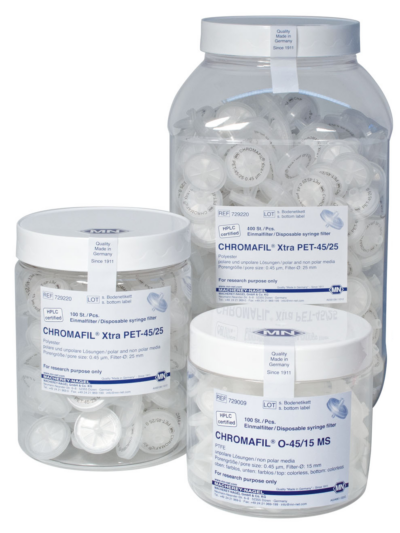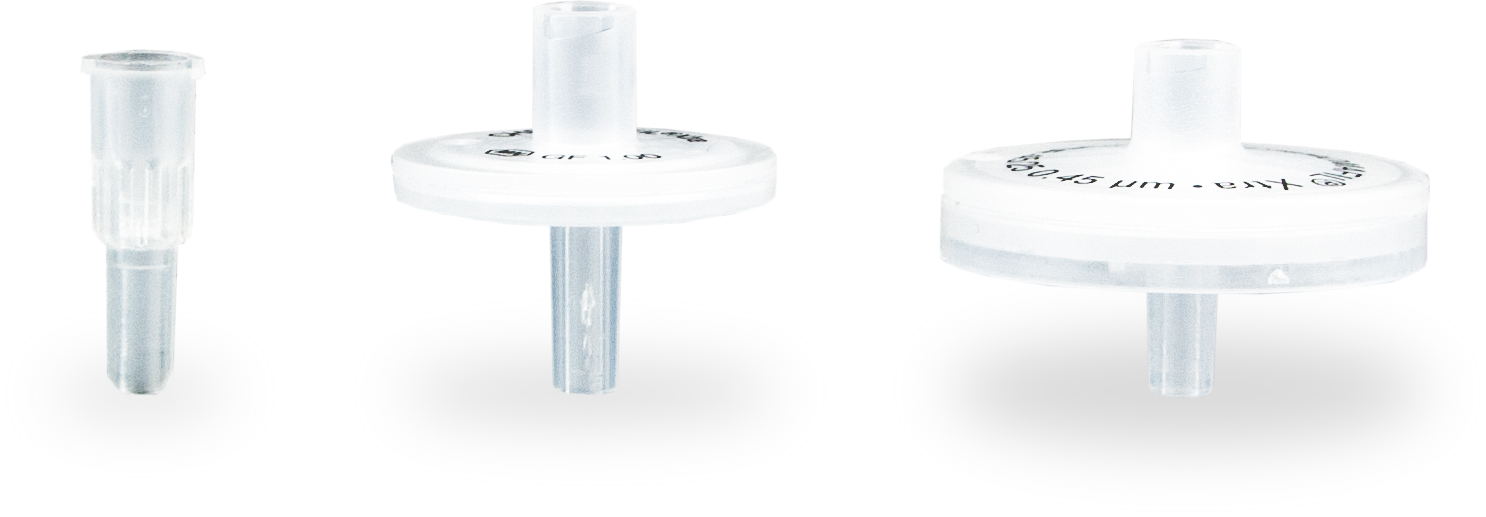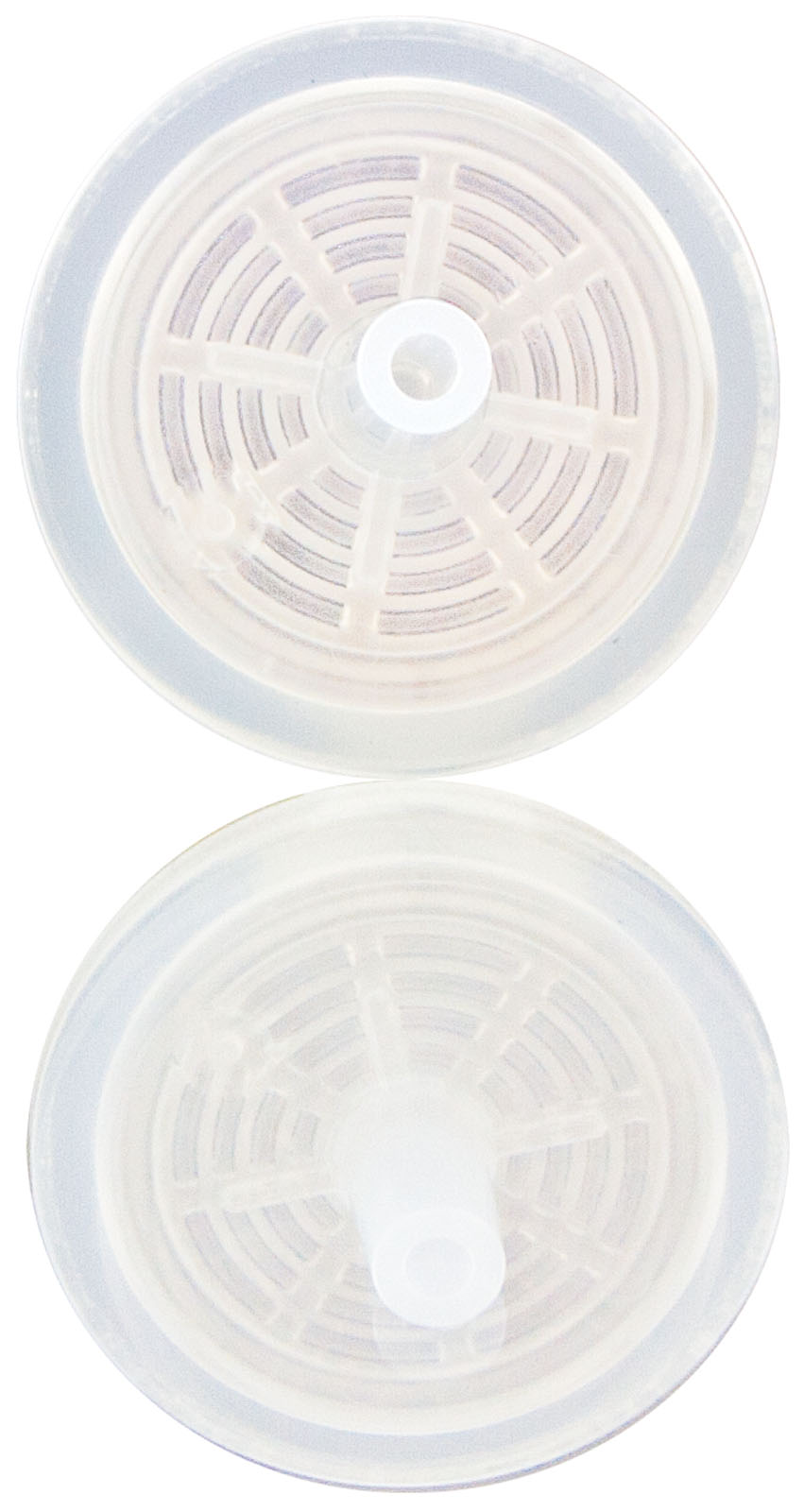Syringe Filters for HPLC and UPLC
Chromafil® Disposable Syringe Filters for Chromatography Sample Prep
CHROMAFIL disposable syringe filters are used for the filtration of suspended matter from liquid samples (1–100 mL) in HPLC and UPLC chromatography sample prep applications before injection.
These syringe filters can be used for HPLC, UPLC, GC, ICP, AAS, TOC, DOC, IR, NMR, photometry, and spectroscopy samples to filter out contaminants and extraneous particles that can affect analytical results or clog liquid pathways, frits, etc.
CHROMAFIL syringe filters are HPLC and UPLC certified for low-extractable content by HPLC evaluation.
A certificate of analysis (COA) is available upon request to meet ISO 9001 requirements.

CHROMAFIL Chromatography Syringe Filters Feature:
- Nine different membrane types to meet multiple filtration applications for aqueous or organic liquid samples
- No extractables, sonically welded, leak-free, chemically resistant, polypropylene housings
- Low-cost, single-application, disposable filters ensure zero cross-contamination problems
- Fast flow geometry minimizes back pressure during filtration by the user. Process samples faster and more easily.
- Very low hold-up volumes for maximum volume recovery
- Certified chromatography performance by HPLC analysis with available COA for ISO 9001 compliance.
- Standard Luer-Lok™ inlet and Luer slip outlet
- Designed to be compatible for use on all common automated filtration systems, e.g. SOTAX® dissolution systems
CHROMAFIL Chromatography Syringe Filters Feature:
- Polypropylene Housing – Stronger solvent stability compared to acrylate and polystyrene filters with low extractable interference.
- Syringe Filters are ultrasonically sealed, not glued – Guaranteed leak-free, stronger with no contamination from glues leaching into the sample
- Filtration in both directions is possible – The bi-directional function allows filtration in aspiration or injection modes.
- Luer-lok inlet secures filter attachment to a syringe – Safe connection on the “high-pressure” side
- Luer exit – Standard luer for 3 mm and 25 mm filters, minispike luer with low dead volume and small OD for 15 mm filters
- Liquid Sample Flow Deflector – The stream of liquid is broken and evenly distributed, and does not directly hit the membrane: this prevents rupture of the membrane, especially with viscous samples
- Star-shaped distribution device – The liquid is evenly distributed to the whole membrane surface: This results in better utilization of the total area. The filter is not plugged up rapidly, providing high flow efficiency.
- Color Coded – For visual identification. Our color coding system permits the user to identify the porosity and type of membrane visually.
- Low Dead Volume for Maximum Sample Recoveries – ~120 µl for 25 mm, 12 µl for 15 mm, 5 µl for 3 mm
Recommended filter size depending on sample volume:
| Sample Volume | Recommended Filter Diameter | Filter Hold-up Volume (approx.) | Available Filtration Area |
|---|---|---|---|
| 1 ml | 3 mm | 0.5 µL | 0.07 cm2 |
| 1 - 5 ml | 15 mm | 12 µL | 1.33 cm2 |
| 5 - 100 ml | 25 mm | 120 µL | 4.91 cm2 |
 Housing Material (Polypropylene)
Housing Material (Polypropylene)
- Lowest Content of Extractable Substances
This low content is due to high-density polypropylene housing. In comparison to filters from polycarbonate, polyacrylate, or polystyrene, all CHROMAFIL® filters are resistant to nearly all organic solvents (See the Chemical Compatibility Table). - Ultrasonically Sealed
The filters are welded, not glued, because glue may have extractable ingredients. Welding leads to a tight connection between both parts, thus the filter can be used in both directions. No fluid can bypass the membrane.

- Special Thick Rim
The thick housing rim is ideal for use in laboratory robots (e. g. SOTAX®, Benchmate™).
Luer Connections
- Luer-lok on the side of the entry
For a safe connection on the high-pressure side, every filter provides a side-entry lure lock. - Luer exit
For 25 and 3 mm filters: standard luer exit. For 15 mm filters: mini spike – This luer configuration offers a low hold-up volume and easy filtration into autosampler vials and NMR tubes. Filter inlet and filter exit can be fitted to all CHROMABOND® columns and accessories for selective sample preparation with the aid of a special adaptor.
“Crash Plate”/Deflector
- No rupture of the membrane due to the “crash” plate
The input solvent stream is “broken” and distributed by the crash plate and does not directly hit the membrane: this prevents the rupture of the membrane by diverting streams into four lanes.
Distributor In “Star” Form
- Optimum flow geometry because of the star shaped distribution device
The stream of liquid is broken into 4 lanes by the impact plate and then further distributed to 8 slots in the form of a star connected with 5 or 8 circular channels (for 15 mm and 25 mm filters, respectively). Thus, the fluid is able to penetrate the membrane on the whole surface, not only on a small region. The filter is not plugged up rapidly, which results in high flow efficiency.
Membranes
- Different Membrane Materials
| Membranes | |
|---|---|
| Polyester | PET (with or without glass fiber pre-filter) |
| Regenerated Cellulose | RC |
| Teflon | PTFE |
| Cellulose Mixed Esters | MV |
| Cellulose Acetate | CA |
| Polyamide | PA |
| Polyethersulfone | PES |
| Polyvinylidene diflouride | PVDF |
| Glass Fiber | GF |
For optimal filtration results using CHROMAFIL® filter consider the following recommendations:
- We recommend either discarding the first 1 ml or rinsing the filter unit with 1 ml of primary solvent before sample filtration
- Before filling the syringe, draw approx. 1 ml air into it. This air helps to minimize the remaining fluid in the filter.
- Start with gentle pressure at the beginning of the filtration. This helps assure maximum throughput. As the filter “accumulates” particles, filtration become more difficult and the pressure will increase on the filter.
- Change filter when resistance becomes excessive in order to avoid housing rupture.
- Do not use CHROMAFIL® syringe filters for direct patient care applications; they are designed for laboratory use only!
- Do not use syringes smaller than 10 ml; the pressure generated may exceed the 6 bar limit of the filter.
- Do not use at temperatures above 55°C (131°F).
- Do not reuse the filter.
CHROMAFIL Disposable Filters
This table lists the chemical compatibility of our CHROMAFIL materials. The chemical compatibility depends on several parameters such as time, pressure and concentration. In most cases, CHROMAFIL filters will have only short contact with a solvent. In these cases they may be used despite limited compatibility. For example, a PTFE filter with PP housing does not liberate any UV-detectable substances during filtration of 5 ml THF, although PP shows only limited resistance towards THF.
INTERACTIVE COMPATIBILITY CALCULATOR
+ Resistant | – Not Resistant | O Limited Resistance
- MV-Cellulose Mixed Esters
- CA-Cellulose Acetate
- RC-Regenerated Cellulose
- PA-Polyamide
- PTFE-Polytetrafluoroethylene (Teflon)
- PVDF-Polyvinylidene difluoride
- PES-Polyethersulfone
- PET-Polyester
- GF-Glass Fiber
- PP-Polypropylene (Housing Material)
| Solvent | Material | |||||||||
|---|---|---|---|---|---|---|---|---|---|---|
| MV | CA | RC | PA | PTFE | PVDF | PES | PET | GF | PP | |
| Acetaldehyde | - | - | + | 0 | + | + | + | + | 0 | |
| Acetic acid, 100% | - | - | - | - | + | + | + | + | + | + |
| Acetone | - | - | + | + | + | + | + | + | + | + |
| Acetonitirle | - | - | + | + | + | + | + | + | + | + |
| Ammonia, 25% | - | - | 0 | - | + | + | + | 0 | + | + |
| Benzene | + | + | + | + | + | 0 | + | + | 0 | |
| n-Butanol | + | + | + | 0 | + | + | + | + | + | + |
| Cyclohexane | + | + | + | 0 | + | + | + | + | + | + |
| Dichloromethane | + | - | + | - | + | + | - | + | + | - |
| Diethyl ether | 0 | 0 | + | + | + | + | + | + | + | 0 |
| Dimethylformamide | - | - | 0 | + | + | - | - | + | + | + |
| 1, 4-Dioxane | - | - | + | + | + | 0 | - | + | + | 0 |
| Ethanol | - | + | + | + | + | + | + | + | + | + |
| Ethyl acetate | - | - | + | + | + | + | + | + | + | 0 |
| Ethylene glycol | 0 | 0 | + | + | + | + | + | + | + | + |
| Formic acid, 100% | + | - | 0 | - | + | + | + | 0 | + | + |
| Hydrochloric acid, 30% | - | - | - | - | + | + | + | - | + | + |
| Methanol | - | - | + | + | + | + | + | + | + | + |
| Nitric acid, 65% | - | - | - | - | 0 | 0 | 0 | + | - | |
| Oxalic acid, 10% aqueous | + | - | + | - | + | + | + | + | + | |
| Petroleum ether | + | + | + | + | + | + | + | + | + | + |
| Phosphoric acid, 80% | - | - | 0 | - | + | 0 | + | + | + | |
| Potassium hydroxide, 1 mol/1 | - | - | 0 | + | + | 0 | + | 0 | + | + |
| 2-Propanol | + | + | + | + | + | + | + | + | + | + |
| Sodium hydroxide, 1 mol/1 | - | - | 0 | + | + | 0 | 0 | 0 | 0 | - |
| Tetrachloromethan | + | - | + | + | + | 0 | + | + | 0 | |
| Tetrahydrofuran | - | - | + | 0 | + | + | - | + | + | - |
| Toluen | + | - | + | + | + | + | + | + | + | - |
| Trichloroethylene | + | + | + | 0 | + | + | + | + | 0 | |
| Trichloromethan | + | - | + | - | + | + | - | + | + | - |
| Urea | + | + | + | + | + | + | + | + | + | |
| Water | + | + | + | + | + | + | + | + | + | + |
| DATA NOT GUARANTEED | ||||||||||
Syringe Filters: A Comprehensive Introduction and Multifaceted Applications in Laboratory Filtration
Abstract: Syringe filters are indispensable tools in laboratory filtration, offering efficient and precise particle removal from liquids and gases. This article presents an in-depth overview of syringe filters, detailing their construction, filtration mechanisms, and the diverse range of applications they serve across various scientific disciplines.
1. Introduction: Syringe filters are vital components of laboratory filtration systems, designed to remove particles and contaminants from liquids and gases. Their compact design, versatility, and ease of use make them a preferred choice for sample preparation in research, quality control, and various analytical applications. This article introduces syringe filters, elucidating their mechanisms of action and highlighting their manifold roles in laboratory science.
2. Syringe Filter Components and Construction: Syringe filters consist of several key components, including a housing, membrane, and connector. The housing serves as a protective casing, while the membrane, typically made of materials like nylon, polytetrafluoroethylene (PTFE), or cellulose acetate, acts as the filtration barrier. The connector allows easy attachment to a syringe or other filtration apparatus.
3. Filtration Mechanisms: Syringe filters employ several filtration mechanisms, including size exclusion, adsorption, and direct interception. Particles larger than the membrane’s pore size are retained on the membrane surface or within its structure, while the filtrate passes through, resulting in clear and particle-free samples.
4. Applications of Syringe Filters:
4.1. Sample Preparation in Analytical Chemistry: Syringe filters play a crucial role in sample preparation for analytical techniques such as high-performance liquid chromatography (HPLC), gas chromatography (GC), and mass spectrometry. They remove particulate matter that could interfere with analyses, ensuring accurate results.
4.2. Environmental Monitoring: In environmental science, syringe filters are used to filter water and air samples, enabling the analysis of pollutants, suspended solids, and microorganisms.
4.3. Pharmaceutical and Biopharmaceutical Analysis: Syringe filters aid in the purification and sterilization of pharmaceutical products and biopharmaceuticals, ensuring product safety and quality. They are employed in filtration steps during drug formulation and quality control.
4.4. Microbiology and Cell Culture: Syringe filters are used in microbiology laboratories to sterilize culture media, buffers, and reagents. They remove bacteria, fungi, and other contaminants, contributing to the maintenance of sterile conditions.
4.5. Food and Beverage Industry: Syringe filters find application in the analysis of food and beverage samples, removing particulates and microbes. They contribute to quality assurance and compliance with regulatory standards.
4.6. DNA and RNA Purification: In molecular biology, syringe filters are used to clarify and filter DNA or RNA samples, ensuring their purity and integrity before downstream applications such as PCR and sequencing.
4.7. Nanoparticle Characterization: Syringe filters aid in the filtration of nanoparticle suspensions, separating particles of different sizes for subsequent analysis and characterization.
5. Selection Considerations: Choosing the appropriate syringe filter involves considering factors such as membrane material, pore size, chemical compatibility, and sample volume. Compatibility with the solvent or medium is crucial to prevent filter degradation and sample contamination.
6. Future Developments: Continued advancements in membrane technology, filter design, and compatibility with a wider range of solvents and samples will enhance the capabilities and versatility of syringe filters.
7. Conclusion: Syringe filters are versatile tools that significantly contribute to laboratory workflows by providing efficient and precise filtration. Their wide-ranging applications across analytical, environmental, pharmaceutical, and molecular biology fields underscore their importance in achieving reliable and accurate results, making them an essential component in modern laboratory practice.


